Out of this world: Hidden treasures of the Snake River Plain
Peeking out of the sagebrush across the Snake River Plain is scattered evidence of the region’s volcanic history: black lava basalt. You may not notice this geological wonder at first glance – the region is relatively flat with some rolling hills and the occasional canyon. But a closer look unveils hints of what lies beneath the entire region. Each year, water flows from the surrounding mountains into the Big Wood River and down into the Snake River Plain’s Magic Reservoir. From there, much of the water is directed to canals that feed the region’s vital agricultural industry. When this happens, areas of the Big Wood River completely dry up – and geological formations that are usually hidden underwater become accessible. Black Magic Canyon is one of these places, and offers a great adventure for those who set out to find it. A visit to Black Magic Canyon shows you how it earned its name. This unusual hidden canyon was carved by the Big Wood River over the last 10,000 years, and offers amazing views – twisting, smooth, black lava rock that features small arches, windows, holes and more.Black Magic Canyon is not the easiest place to find, but this geological treasure, located on lands managed by the Bureau of Land Management, is worth the visit. It’s a small canyon located north of Shoshone, along Idaho State Highway 75. There are multiple sections of canyon you can visit, some of which are easier to find than others. The most popular stretch is easy to find information on and easy to access – a parking area can be found on Google Maps, and even has informational signs along the short pathway to the canyon that offer insight into the history of the region. Other sections of the canyon remain off the beaten path, and require a deeper search on maps and dirt roads to find them.
A visit to Black Magic Canyon shows you how it earned its name. This unusual hidden canyon was carved by the Big Wood River over the last 10,000 years, and offers amazing views – twisting, smooth, black lava rock that features small arches, windows, holes and more.Black Magic Canyon is not the easiest place to find, but this geological treasure, located on lands managed by the Bureau of Land Management, is worth the visit. It’s a small canyon located north of Shoshone, along Idaho State Highway 75. There are multiple sections of canyon you can visit, some of which are easier to find than others. The most popular stretch is easy to find information on and easy to access – a parking area can be found on Google Maps, and even has informational signs along the short pathway to the canyon that offer insight into the history of the region. Other sections of the canyon remain off the beaten path, and require a deeper search on maps and dirt roads to find them.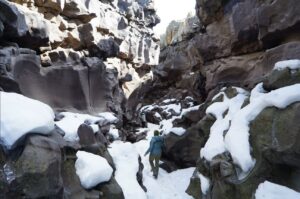 Even though releases from Magic Reservoir are limited to the growing season (roughly May through September) water can still flow through the canyon any month of the year. The canyon tends to dry up toward the end of summer, and usually remains dry through the winter and early spring, when it’s safe to explore. Big Wood Canal Company controls the flow of water through the canyon, so any excursion needs to start with a call to them. If you don’t check ahead of time, you could find yourself in serious trouble with a flash flood. After confirming that Magic Dam was still closed, ICL’s Snake River team recently visited the area to explore this geological wonder. Our group met at the parking area for Black Magic Canyon and prepared for a brisk walk down into the canyon. It was a windy day, but the sun shining above offered some warmth – especially as it heated up the black rock around us. The sounds of Killdeer flying above us filled the sky, along with an occasional song from Western Meadowlarks. As the sun rose higher, the birdsong from the recent arrivals and the warming temperatures made it feel like a proper spring morning.
Even though releases from Magic Reservoir are limited to the growing season (roughly May through September) water can still flow through the canyon any month of the year. The canyon tends to dry up toward the end of summer, and usually remains dry through the winter and early spring, when it’s safe to explore. Big Wood Canal Company controls the flow of water through the canyon, so any excursion needs to start with a call to them. If you don’t check ahead of time, you could find yourself in serious trouble with a flash flood. After confirming that Magic Dam was still closed, ICL’s Snake River team recently visited the area to explore this geological wonder. Our group met at the parking area for Black Magic Canyon and prepared for a brisk walk down into the canyon. It was a windy day, but the sun shining above offered some warmth – especially as it heated up the black rock around us. The sounds of Killdeer flying above us filled the sky, along with an occasional song from Western Meadowlarks. As the sun rose higher, the birdsong from the recent arrivals and the warming temperatures made it feel like a proper spring morning. 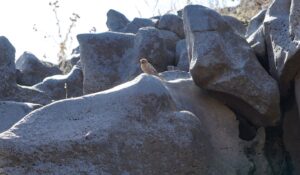 It’s a short walk from the parking area down to the canyon itself. From our cars, views consisted of a brown and sage landscape, but we could see dark walls of rock ahead of us. As we continued downward, our surroundings rapidly changed. The light hues of brown and green were no more. Varying shades of gray swirled around us, as we began to explore what is normally underwater.The rock surrounding us was basalt, which is the result of a shield volcano that erupted 10,000 years ago and created the Shoshone Lava Flows. When the volcano erupted, lava began to fill the historic channel of the Big Wood River. Lava eventually filled the river in its entirety, pushing the river to the west, where it began to carve a new path through the Shoshone Lava Flows. Over time, the river carved deeper through the rock, and the bedload (small gravel-sized rocks made from the hardest rocks in the area) began to smooth jagged edges of the porous basalt – leaving behind basalt walls that are smooth to the touch. Views within the canyon are otherworldly. The narrow path through the canyon resembles some of Utah’s slot canyons, but rather than the smooth red rock found there, here you’re surrounded by towering walls of intricately shaped black basalt.
It’s a short walk from the parking area down to the canyon itself. From our cars, views consisted of a brown and sage landscape, but we could see dark walls of rock ahead of us. As we continued downward, our surroundings rapidly changed. The light hues of brown and green were no more. Varying shades of gray swirled around us, as we began to explore what is normally underwater.The rock surrounding us was basalt, which is the result of a shield volcano that erupted 10,000 years ago and created the Shoshone Lava Flows. When the volcano erupted, lava began to fill the historic channel of the Big Wood River. Lava eventually filled the river in its entirety, pushing the river to the west, where it began to carve a new path through the Shoshone Lava Flows. Over time, the river carved deeper through the rock, and the bedload (small gravel-sized rocks made from the hardest rocks in the area) began to smooth jagged edges of the porous basalt – leaving behind basalt walls that are smooth to the touch. Views within the canyon are otherworldly. The narrow path through the canyon resembles some of Utah’s slot canyons, but rather than the smooth red rock found there, here you’re surrounded by towering walls of intricately shaped black basalt.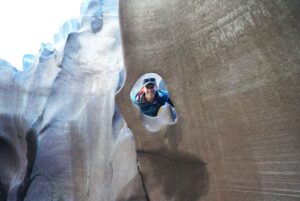 There are various rock formations throughout the canyon – keyholes give glimpses of upriver, cylindrical potholes offer refuge for small creatures, larger rocks provide places to rest for visitors big and small. The deep canyon also protected snow and ice in its shadowy crevices, even as much of the uplands were free of snow. We oohed and awed as we slowly meandered through the canyon, and climbed up the dry river bed with excitement to see what was around the next bend.After exploring the river bottom, the team headed into the Black Butte Wilderness Study Area to see the origin of Shoshone Lava Flows – the Black Butte Crater. Black Butte Crater, a lava field created by the same shield volcano that erupted ~10,000 years ago, also gives a great view of the region’s geological history. Surrounding the crater, basalt peppers the landscape, with a sea of sagebrush covering the lower flanks of the crater in every direction.
There are various rock formations throughout the canyon – keyholes give glimpses of upriver, cylindrical potholes offer refuge for small creatures, larger rocks provide places to rest for visitors big and small. The deep canyon also protected snow and ice in its shadowy crevices, even as much of the uplands were free of snow. We oohed and awed as we slowly meandered through the canyon, and climbed up the dry river bed with excitement to see what was around the next bend.After exploring the river bottom, the team headed into the Black Butte Wilderness Study Area to see the origin of Shoshone Lava Flows – the Black Butte Crater. Black Butte Crater, a lava field created by the same shield volcano that erupted ~10,000 years ago, also gives a great view of the region’s geological history. Surrounding the crater, basalt peppers the landscape, with a sea of sagebrush covering the lower flanks of the crater in every direction.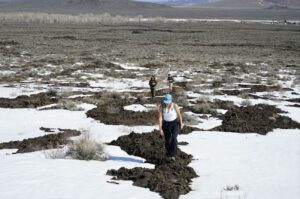 The sagebrush steppe around the crater is home to some of Idaho’s smaller wildlife – a sage grouse startled us as it erupted from the tall sagebrush, and cottontail rabbits scurried out of their hiding places as we approached. As we moved through the sagebrush, we tread carefully and spread out to minimize impacts to the trailless area. Although the sun made us feel like we were well into spring, we were reminded that it was not when snow had us post-holing across the landscape – carefully placing our feet to avoid plunging through the layer of crusty snow. As we approached the ascent to the crater rim, the snow disappeared, revealing sharp, rough and unstable basalt. A hollow echoing thud accompanied each step, as the basalt shifted below our feet. The jagged, loose rock isn’t the easiest landscape to trek across – so we only recommend this hike for adults in sturdy shoes and with good balance and navigation skills. Dogs should be left at home for this adventure, as the jagged rocks can cut their paws. We also recommend this as a spring/fall hike, as a hot sun, black rock and lack of shade will make a summer climb unbearable.
The sagebrush steppe around the crater is home to some of Idaho’s smaller wildlife – a sage grouse startled us as it erupted from the tall sagebrush, and cottontail rabbits scurried out of their hiding places as we approached. As we moved through the sagebrush, we tread carefully and spread out to minimize impacts to the trailless area. Although the sun made us feel like we were well into spring, we were reminded that it was not when snow had us post-holing across the landscape – carefully placing our feet to avoid plunging through the layer of crusty snow. As we approached the ascent to the crater rim, the snow disappeared, revealing sharp, rough and unstable basalt. A hollow echoing thud accompanied each step, as the basalt shifted below our feet. The jagged, loose rock isn’t the easiest landscape to trek across – so we only recommend this hike for adults in sturdy shoes and with good balance and navigation skills. Dogs should be left at home for this adventure, as the jagged rocks can cut their paws. We also recommend this as a spring/fall hike, as a hot sun, black rock and lack of shade will make a summer climb unbearable. 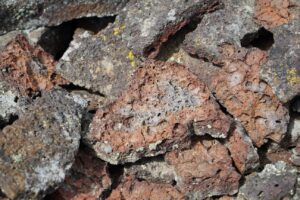 As we reached the northern summit of Black Butte Crater, we were greeted by expansive views of the Snake River Plain. The view was incredible – the horizon was bordered by the towering peaks of the Pioneer, Soldier and Smoky mountain ranges. The gaping hole that makes Black Butte Crater and the thirty mile river of basalt is all that is left of the shield volcano that formed left its mark on this landscape. After enjoying lunch with this beautiful vista, we made our way back down the rugged slopes of the crater, discussing the people that have lived here since time immemorial. The challenges we faced while navigating this rugged terrain built a greater admiration for the people who first traveled through and lived in this area – Bannock and Shoshone Tribal members. We also spoke of the early settlers who traveled the Oregon Trail across the Snake River Plain to the south and, in some instances, chose to stay in this rugged landscape. From Tribes to pioneers, to trains and mining, the area is just as rich in human history as geologic.
As we reached the northern summit of Black Butte Crater, we were greeted by expansive views of the Snake River Plain. The view was incredible – the horizon was bordered by the towering peaks of the Pioneer, Soldier and Smoky mountain ranges. The gaping hole that makes Black Butte Crater and the thirty mile river of basalt is all that is left of the shield volcano that formed left its mark on this landscape. After enjoying lunch with this beautiful vista, we made our way back down the rugged slopes of the crater, discussing the people that have lived here since time immemorial. The challenges we faced while navigating this rugged terrain built a greater admiration for the people who first traveled through and lived in this area – Bannock and Shoshone Tribal members. We also spoke of the early settlers who traveled the Oregon Trail across the Snake River Plain to the south and, in some instances, chose to stay in this rugged landscape. From Tribes to pioneers, to trains and mining, the area is just as rich in human history as geologic. 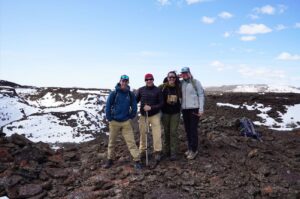 Our adventure left us as any good one should – tired, happy, and more in awe of our Gem State. Black Magic Canyon and Black Butte Crater are just two of the many geological marvels that exist in the Snake River Plain. As spring continues to bring us outside, we encourage you to get out and get to know some of these hidden gems, but make sure you recreate responsibly. Come prepared with the proper gear and enough food and water, and let someone know where you’re going. Try and leave the landscape better than you found it – make sure you pack out what you pack in, and pick up any pieces of trash you may come across. If these places are to remain special, we have to do our part to keep them that way.
Our adventure left us as any good one should – tired, happy, and more in awe of our Gem State. Black Magic Canyon and Black Butte Crater are just two of the many geological marvels that exist in the Snake River Plain. As spring continues to bring us outside, we encourage you to get out and get to know some of these hidden gems, but make sure you recreate responsibly. Come prepared with the proper gear and enough food and water, and let someone know where you’re going. Try and leave the landscape better than you found it – make sure you pack out what you pack in, and pick up any pieces of trash you may come across. If these places are to remain special, we have to do our part to keep them that way.
You can learn more about special places in the Snake River Plain, like Black Magic Canyon and the Black Butte Wilderness Study area. Sign up for our Snake River campaign updates, and get tips for your next adventure and learn about how you can help protect these hidden treasures.

